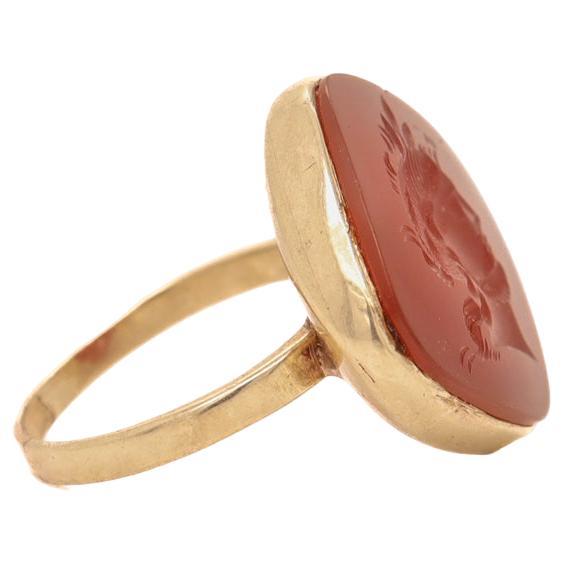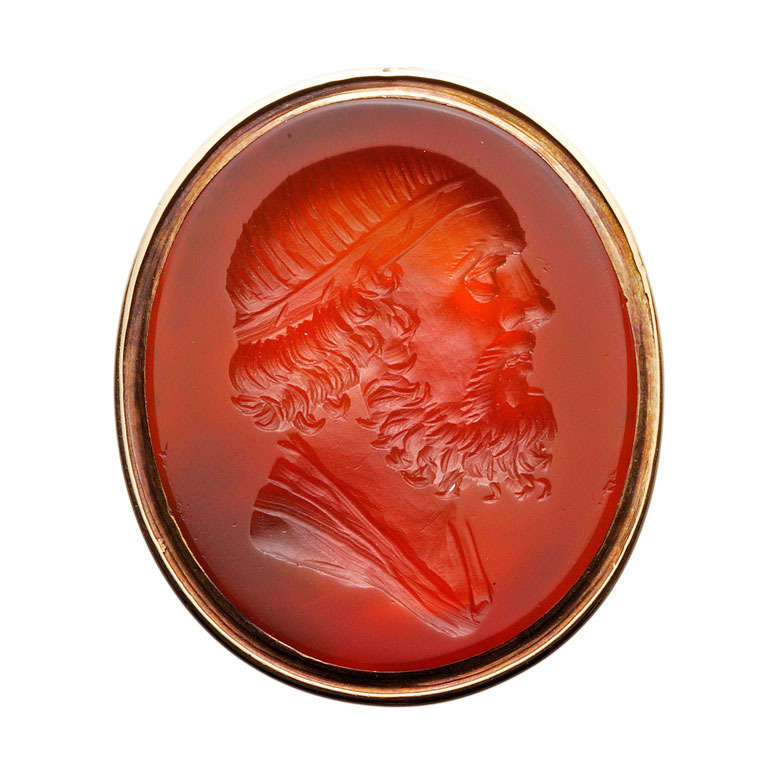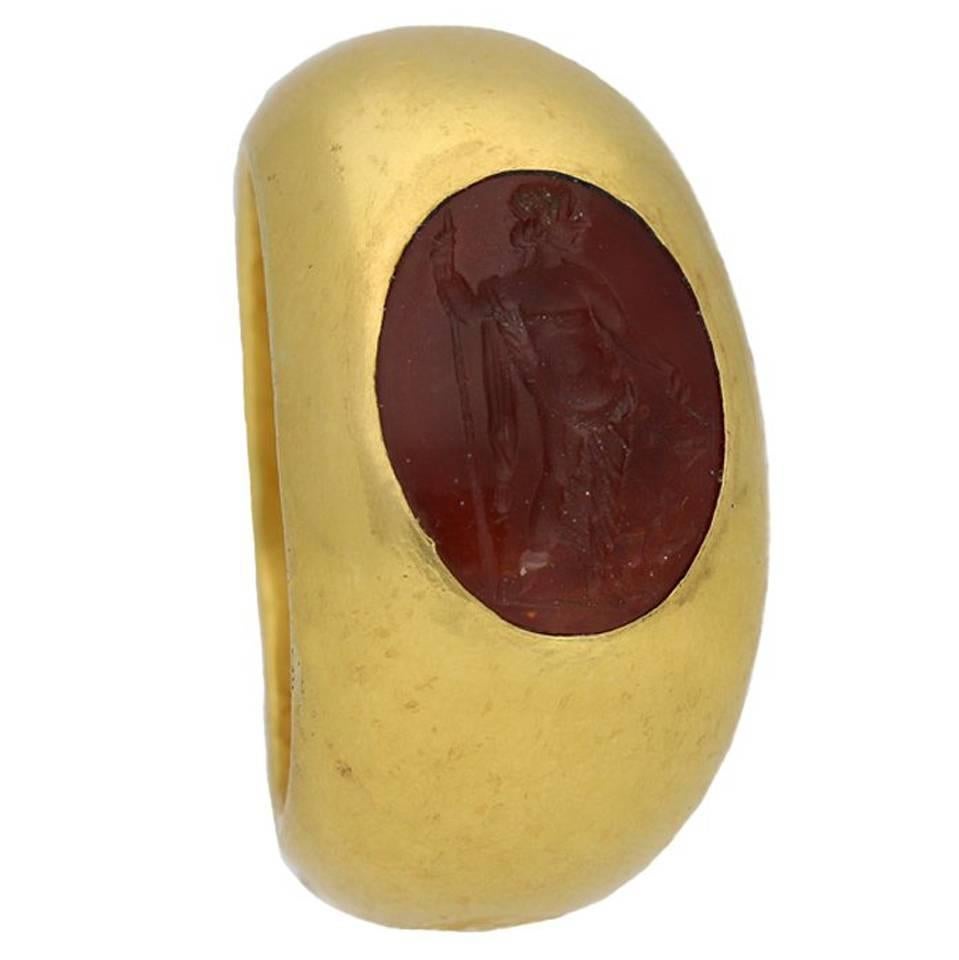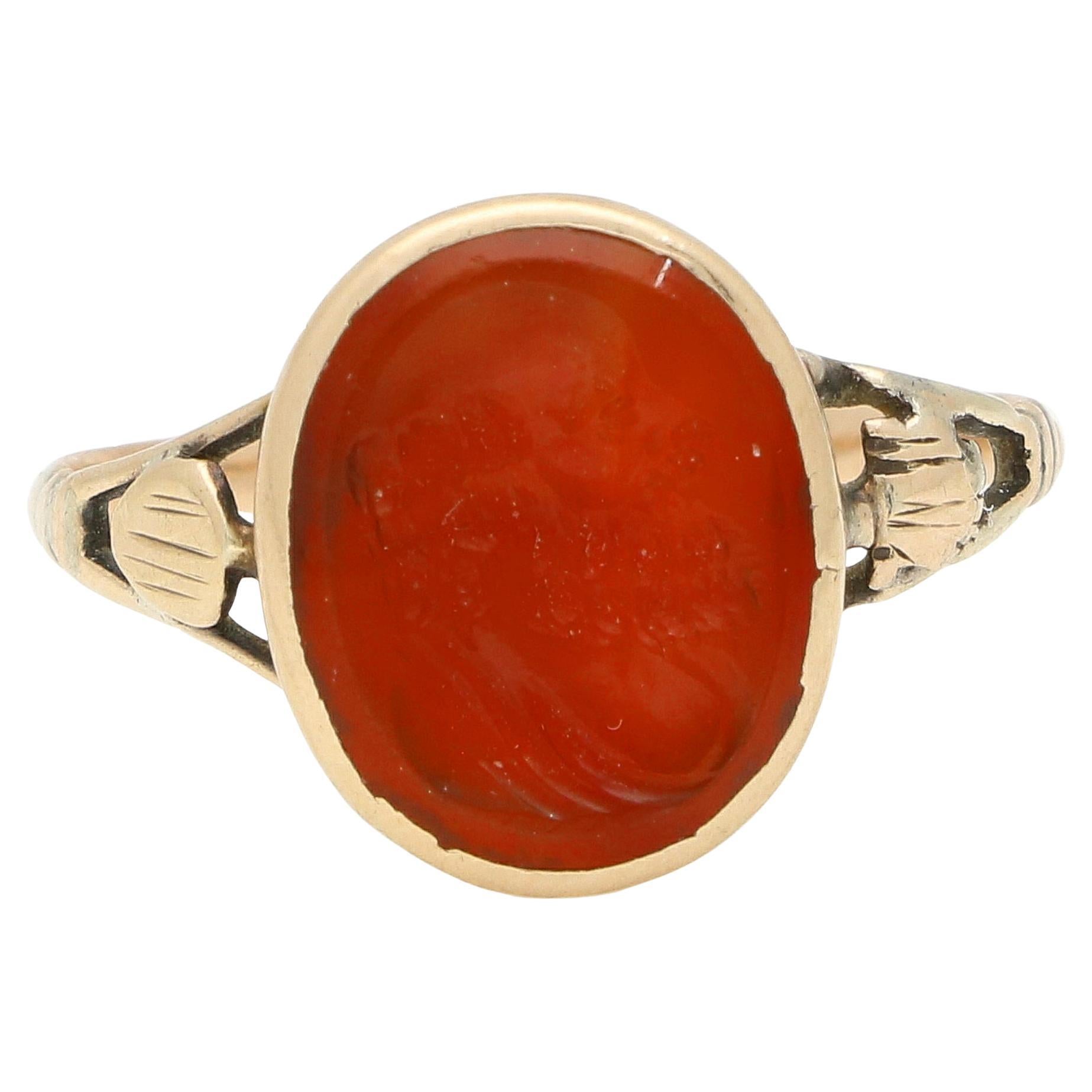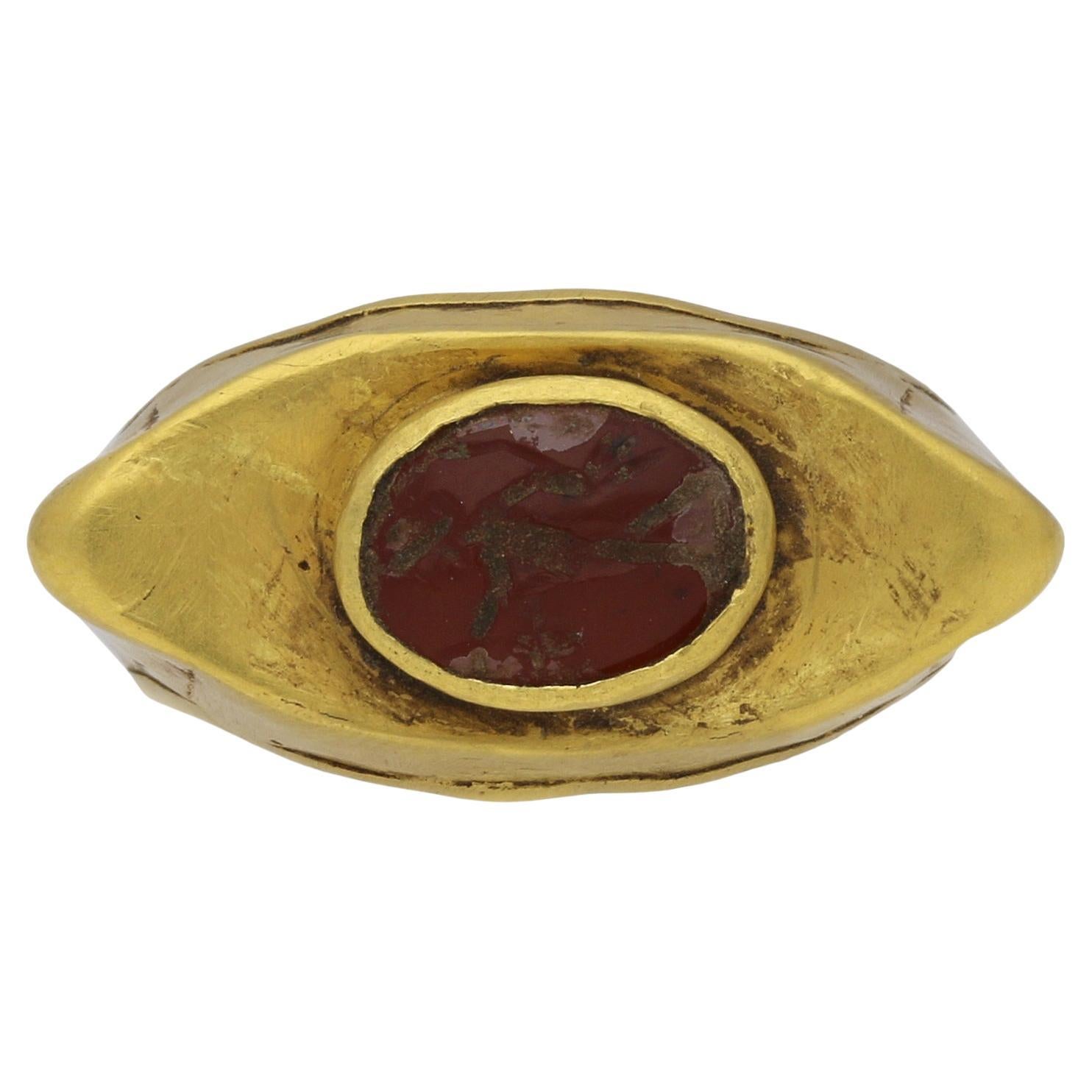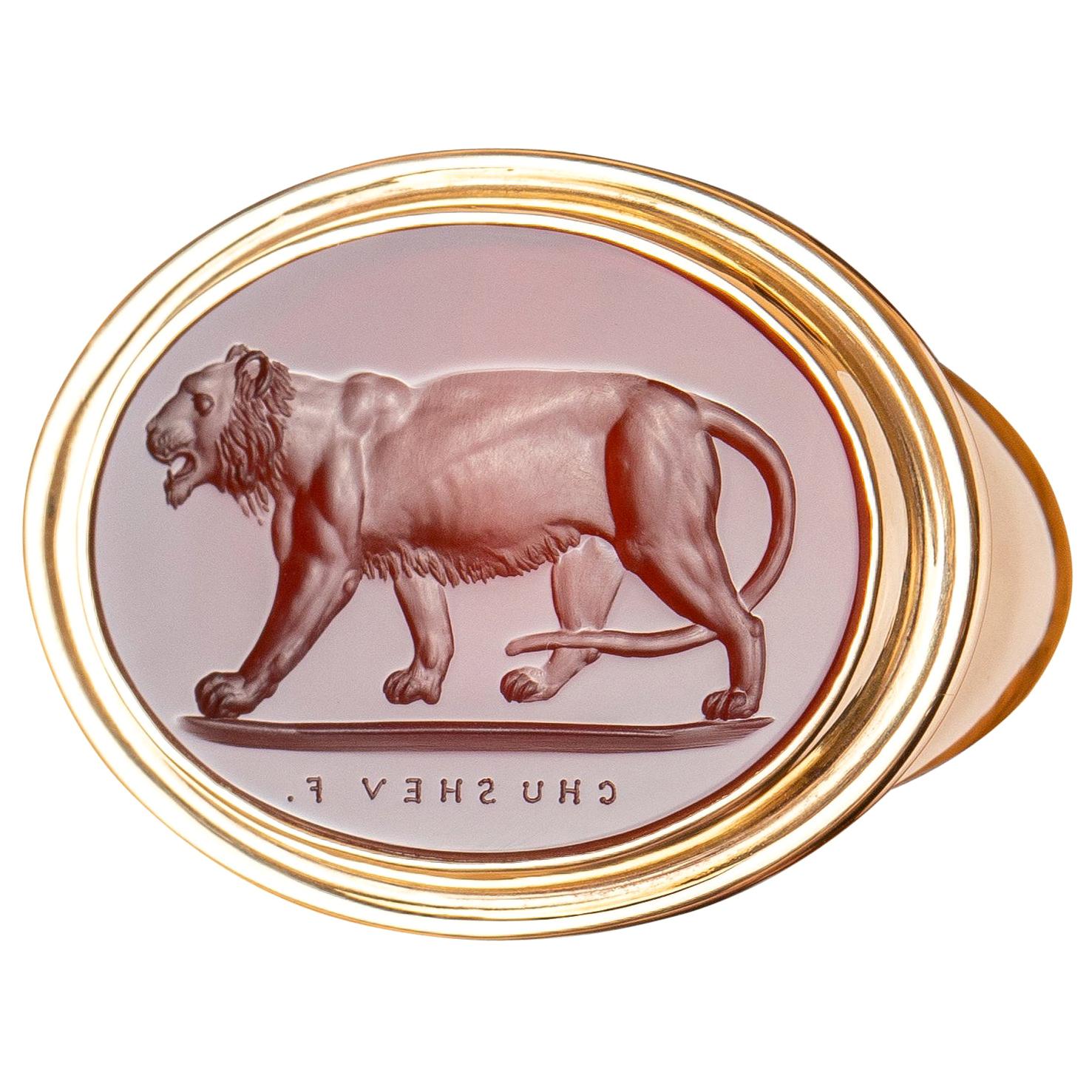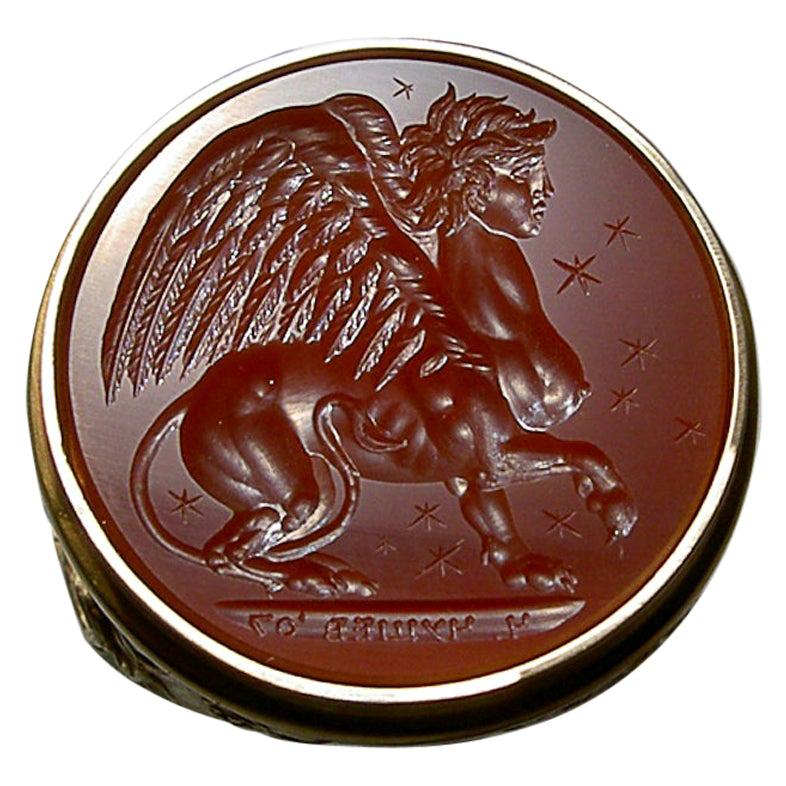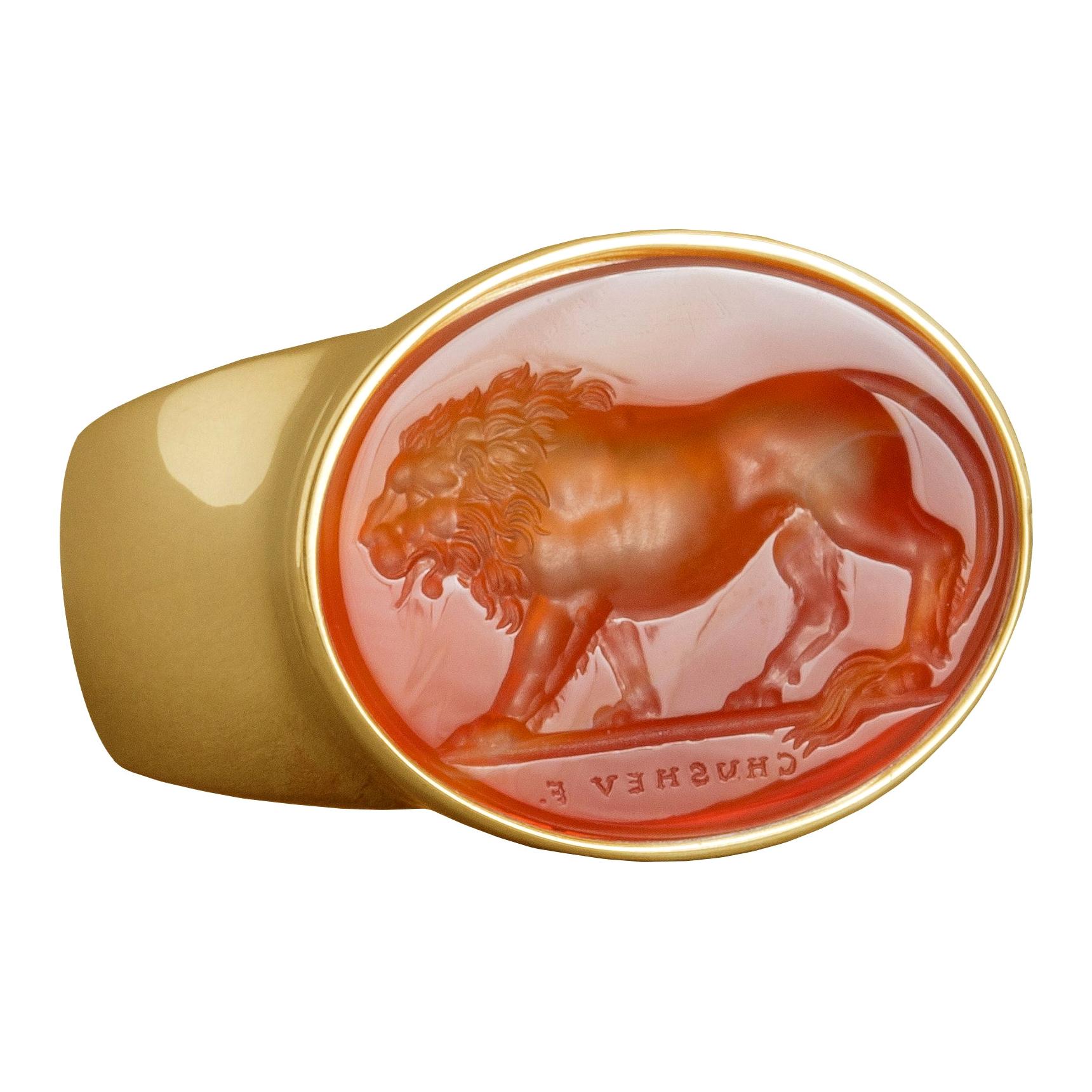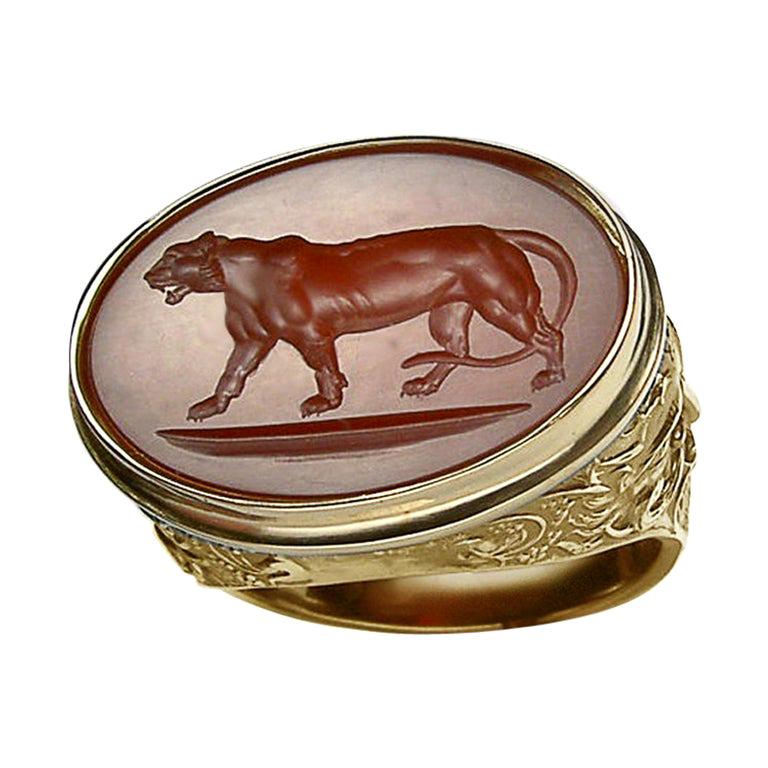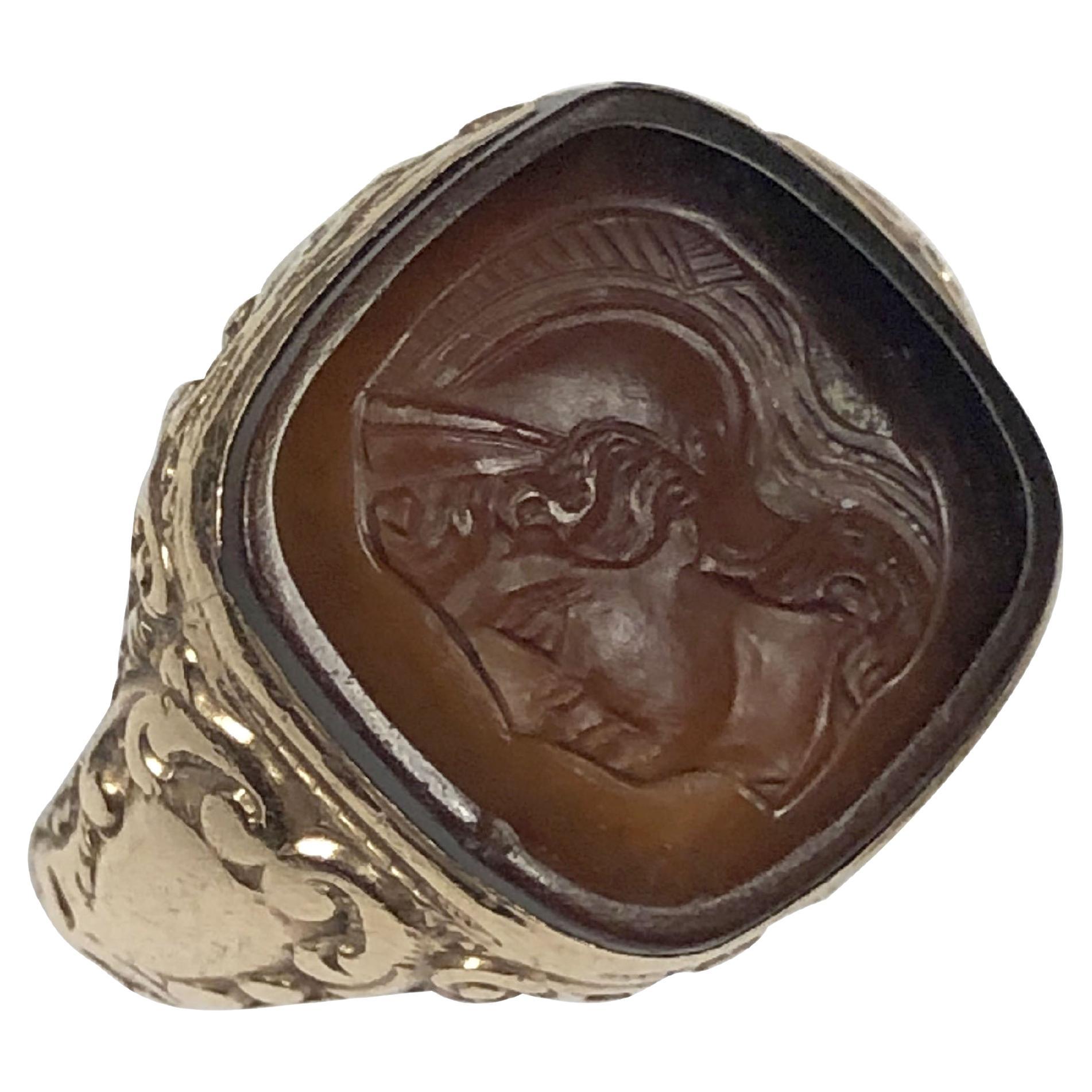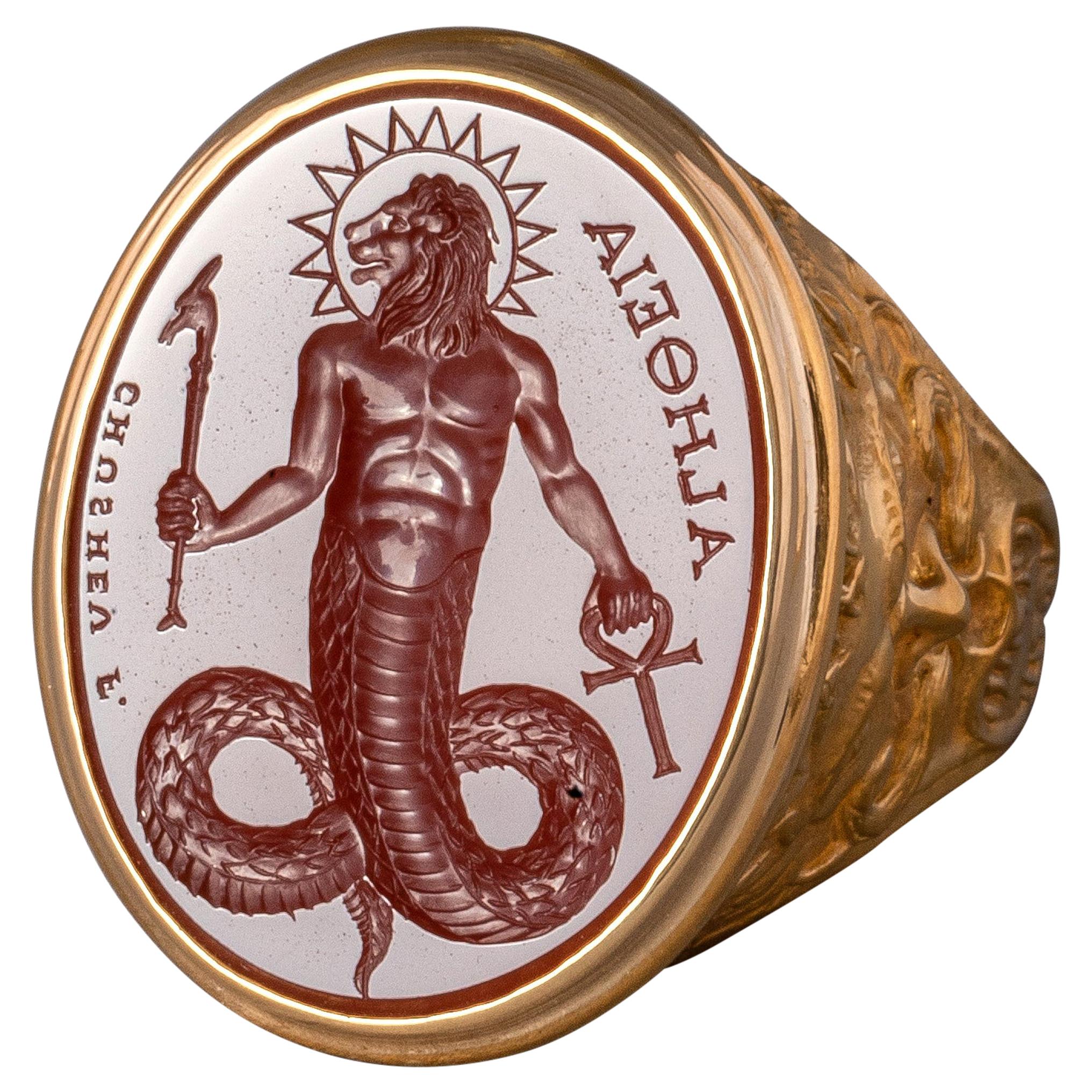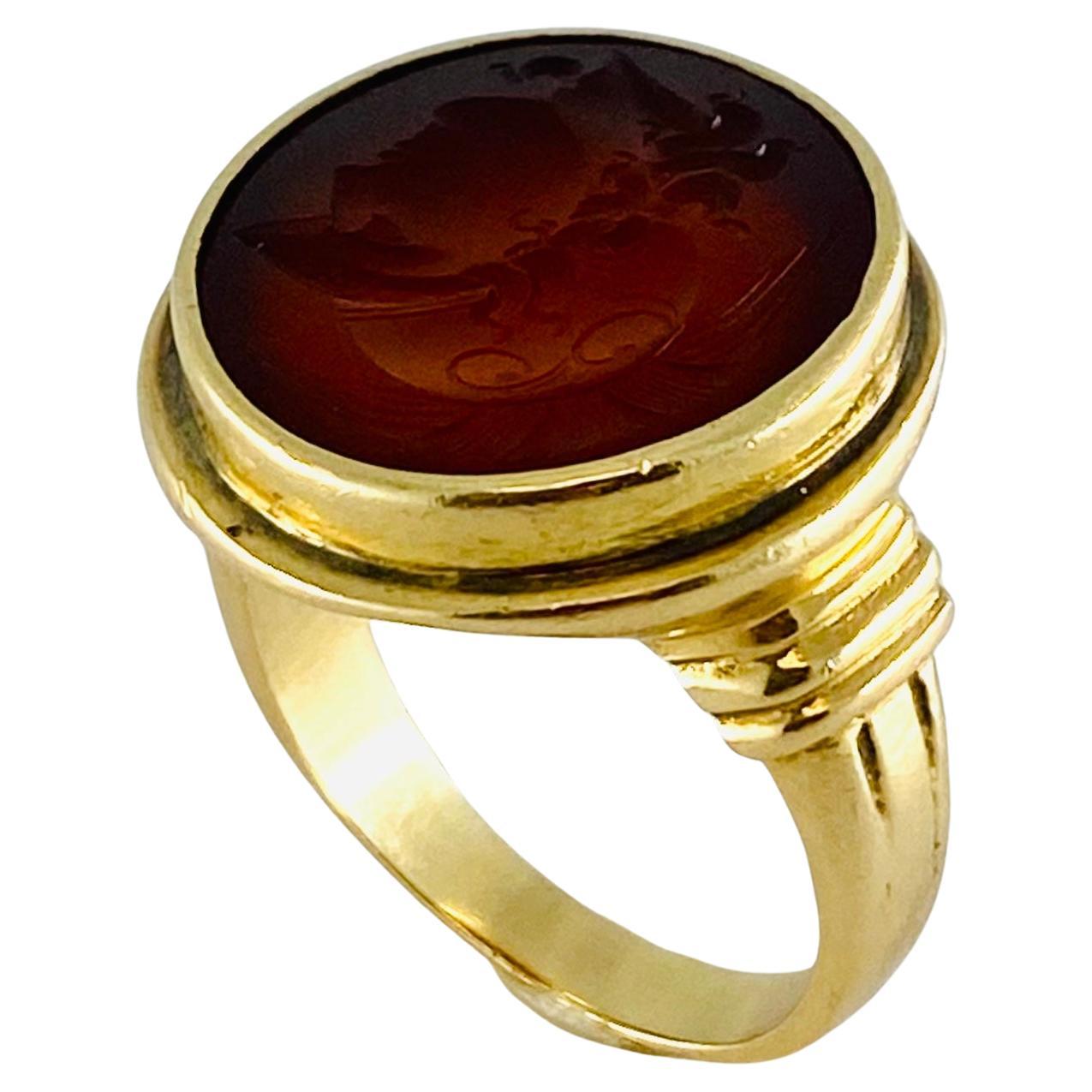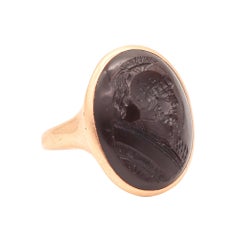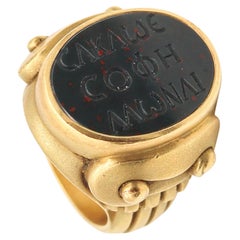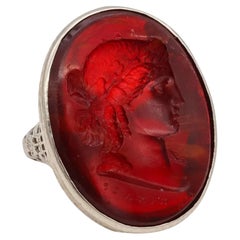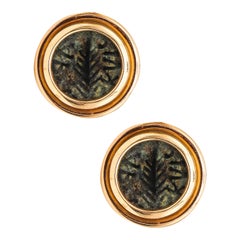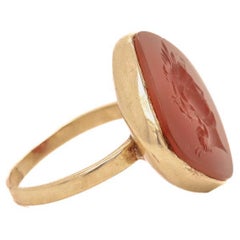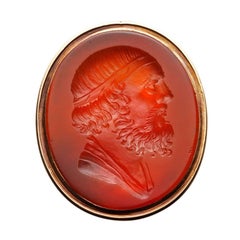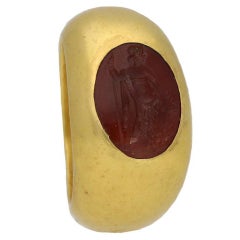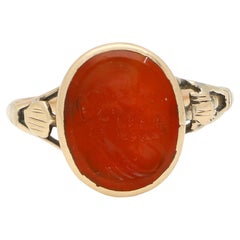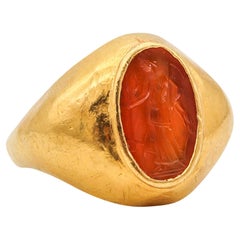
ANCIENT ROME 100-200 AD Signet Intaglio Ring In 23Kt Gold & Carved Carnelian
View Similar Items
Want more images or videos?
Request additional images or videos from the seller
1 of 10
ANCIENT ROME 100-200 AD Signet Intaglio Ring In 23Kt Gold & Carved Carnelian
About the Item
- Creator:Ancient Roman Ring
- Ring Size:8.5 US, Not Resizable
- Metal:
- Stone:
- Stone Cut:
- Weight:9.1 g
- Style:
- Place of Origin:
- Period:
- Date of Manufacture:100-200 AD
- Condition:Wear consistent with age and use. The overall condition of this ancient Roman ring is excellent. Beside the little normal wear, there is no damage to the gold. The intaglio is secured in the settings. This piece has been carefully inspected to guarantee the condition and authenticity.
- Seller Location:Miami, FL
- Reference Number:Seller: R111424SANM/.27701stDibs: LU2690224901712
About the Seller
5.0
Recognized Seller
These prestigious sellers are industry leaders and represent the highest echelon for item quality and design.
Platinum Seller
Premium sellers with a 4.7+ rating and 24-hour response times
Established in 1995
1stDibs seller since 2022
807 sales on 1stDibs
Authenticity Guarantee
In the unlikely event there’s an issue with an item’s authenticity, contact us within 1 year for a full refund. DetailsMoney-Back Guarantee
If your item is not as described, is damaged in transit, or does not arrive, contact us within 7 days for a full refund. Details24-Hour Cancellation
You have a 24-hour grace period in which to reconsider your purchase, with no questions asked.Vetted Professional Sellers
Our world-class sellers must adhere to strict standards for service and quality, maintaining the integrity of our listings.Price-Match Guarantee
If you find that a seller listed the same item for a lower price elsewhere, we’ll match it.Trusted Global Delivery
Our best-in-class carrier network provides specialized shipping options worldwide, including custom delivery.More From This Seller
View AllINTAGLIO 1900 Antique Signet Ring In 14Kt Yellow Gold With Carved Brown Agate
Located in Miami, FL
An antique intaglio signet ring.
This is a gorgeous antique signet ring, created in England during the Edwardian period, back in the 1900. The ring has been crafted with smooth line...
Category
Antique Early 1900s English Edwardian Signet Rings
Materials
Agate, 14k Gold, Yellow Gold, Gold
KIESELSTEIN CORD 1984 Signet Intaglio Ring In 18Kt Yellow Gold With Bloodstone
By Kieselstein
Located in Miami, FL
A signet intaglio ring designed by Kieselstein-Cord.
This is a massive oversized signet ring created in New York City at the jewelry atelier of Kieselstein-Cord, back in 1984. This ...
Category
Vintage 1980s American Classical Greek Signet Rings
Materials
Agate, 18k Gold, Yellow Gold, Gold
Giovanni & Luigi Pichler 1790 Oval Intaglio Carved In Amber Mounted in 18Kt Ring
Located in Miami, FL
Important carved intaglio ring by Giovanni or Luigi Pichler (1773-1854).
Fabulous and extremely rare intaglio seal piece, created in Europe by th...
Category
Antique 1790s Italian Neoclassical Signet Rings
Materials
Amber, 18k Gold, White Gold
$14,812 Sale Price
25% Off
Free Shipping
Ancient Rome Judaea 58 AD Bronze Prutah Coins Cufflinks in 14Kt Yellow Gold
Located in Miami, FL
Cufflinks with ancient Roman coins from Judaea.
Great pair of rare ancient Judean (Jerusalem) coins minted during the period of the Roman Empire administration. These bronze coins were called Prutah and were minted in the city of Jerusalem around 58-59 AD. Cradled in the name of the Roman procurator Porcio Festo (59-62 AD) under the rule of Emperor Nero (54-68 AD).
These genuine coins was carefully mounted in an elaborated cufflinks with double frames crafted in solid yellow gold of 14 karats with polished finish and fitted with movable hinged pressured T-bars for comfort fit.
Obverse: Greek letters KAICAPOC (Caesar) and date LЄ (year 5=58/59 A.D), palm branch.
Reverse: Greek letters NЄP WNO C (Nero) in wreath tied at the bottom with an X.
Mint: Roman mint at Jerusalem.
Numismatic Literature: Hendin-1351 (5th Edition); Hendin-653 (3rd Edition).
Weight: Total of 17.8 Grams, (11.41 Dwt). Coins are approximate 2.45 Grams each.
Measurements: 21.6 mm by 21.6 mm (0.85 x 0.85 Inches).
Hallmarks: Stamped with the maker's mark and the 14kt gold assay mark.
Porcius Festus was procurator of Judea from about AD 58 to 62, succeeding Antonius Felix. His exact time in office is not known. He inherited all of the problems of his predecessor in regard to the Roman practice of creating civic privileges for Jews. Only one other issue bedeviled his administration, the controversy between Agrippa II and the priests in Jerusalem regarding the wall erected at the temple to break the view of the new wing of Agrippa's palace.
During his administration, Jewish hostility to Rome was greatly inflamed by the civic privileges issue. Feelings were aroused which played an important part in the closely following Jewish War of AD 66.
In the New Testament, the Apostle Paul had his final hearing before Festus. In Acts 25:12, Festus sought to induce Paul to go to Jerusalem for trial; Paul appealed to the Emperor. the appeal resulted in Paul being deported to Rome in the autumn of AD 58. Acts 25-26.
Nero (Latin: Nero Claudius Caesar Augustus Germanicus;15 December 37 - 9 June 68) was Roman Emperor from 54 to 68, and the last in the Julio-Claudian dynasty. Nero was adopted by his great uncle Claudius to become his heir and successor, and succeeded to the throne in 54 following Claudius' death. During his reign, Nero focused much of his attention on diplomacy, trade, and enhancing the cultural life of the Empire. He ordered theaters built and promoted athletic games. During his reign, the redoubtable general Corbulo conducted a successful war and negotiated peace with the Parthian Empire. His general Suetonius Paulinus crushed a revolt in Britain. Nero annexed the Bosporan Kingdom to the Empire and began the First Roman-Jewish War.
In 64, most of Rome was destroyed in the Great Fire of Rome, which many Romans believed Nero himself had started in order to clear land for his planned palatial complex, the Domus Aurea. In 68, the rebellion of Vindex in Gaul and later the acclamation of Galba in Hispania drove Nero from the throne. Facing assassination, he committed suicide on 9 June 68 (the first Roman emperor to do so) His death ended the Julio-Claudian Dynasty, sparking a brief period of civil wars known as the Year of the Four Emperors. Nero's rule is often associated with tyranny and extravagance. He is known for many executions, including that of his mother, and the probable murder by poison of his stepbrother Britannicus.
He is infamously known as the Emperor who "fiddled while Rome burned" and as an early persecutor of Christians. He was known for having captured Christians to burn them in his garden at night for a source of light. This view is based on the writings of Tacitus, Suetonius, and Cassius Dio, the main surviving sources for Nero's reign. Few surviving sources paint Nero in a favorable light. Some sources, though, including some mentioned above, portray him as an emperor who was popular with the common Roman people, especially in the East. Some modern historians question the reliability of ancient sources when reporting on Nero's tyrannical acts.
Prutah (Hebrew: פרוטה) is a word borrowed from the Mishnah and the Talmud, in which it means "a coin of smaller value". The word was probably derived originally from an Aramaic word with the same meaning. The prutah was an ancient copper Jewish coin...
Category
Late 20th Century Italian Classical Roman Cufflinks
Materials
14k Gold, Yellow Gold, Bronze
$1,762 Sale Price
25% Off
Free Shipping
Giovanni & Luigi Pichler 1790 Rare Agate Carved Intaglio of Mercury in 14kt Gold
Located in Miami, FL
Important carved intaglio ring by Giovanni or Luigi Pichler (1773-1854).
An extremely rare intaglio seal piece, created in Rome Italy by the Pichler's Atelier in the late early 18th century, circa 1795. It was carved in an oval cabochon cut shape, from a triple layered translucent bluish agate.
The intaglio seal depicts the naked figure of the Roman goddess Mercury, in running flying position to the right with a helmet and winged sandals. Raising his left hand and holding a trophy with the right hand. A butterfly or flying insect at the right. Signed, Pichler in Greek (ΠΙΧΛΕΡ), for Giovanni or Luigi Pichler (1773-1854).
This seal has been made after the famous Flying Mercury (Mercure volant) statue, created by the mannerist sculptor Giambologna (Giovanni da Bologna 1524-1608), a Flemish-Italian sculptor that work all his life mostly in Florence in Italy. One of the versions of the actual sculpture is located at the Bargello Museum in Florence Italy and the other at the Louvre Museum in Paris.
Mercury. in Latin Mercurius, in Roman religion is the god of shopkeepers and merchants, travelers and transporters of goods, and thieves and tricksters. He is commonly identified with the Greek Hermes...
Category
Antique Early 18th Century Italian Classical Roman Signet Rings
Materials
Fire Agate, Agate, White Gold, 14k Gold, Gold
$4,488 Sale Price
25% Off
Free Shipping
CARTIER 1970 Modernist Enameled Signet Ring In 18Kt Yellow Gold With Diamonds
By Cartier
Located in Miami, FL
Geometric signet ring designed by Cartier.
This is a very unusual signet ring, created back in the 1970 by the jewelry house of Cartier. This ring has been crafted as a piece of Ita...
Category
Vintage 1970s French Modernist Signet Rings
Materials
White Diamond, Diamond, 18k Gold, Enamel, Yellow Gold, Gold
$6,712 Sale Price
25% Off
Free Shipping
You May Also Like
Antique Gold & Carved Carnelian Intaglio Signet Ring with an Ancient Roman Hero
Located in Philadelphia, PA
A fine antique intaglio ring.
Likely converted from an antique button or pin.
In 14k gold
With a carved carnelian cabochon depicting an unidentified Roman hero.
Marked 14k to the...
Category
20th Century Etruscan Revival Signet Rings
Materials
Carnelian, Gold
Georgian Carnelian Intaglio Gold Signet Ring
Located in London, GB
A Georgian carnelian intaglio ring, the oval cornelian measuring 21 x 18mm, seal-engraved with a classic male head, bearded and in profile, in a yel...
Category
Antique Early 19th Century British Georgian Signet Rings
Materials
Carnelian, Yellow Gold, Gold
Ancient 2nd Century AD Roman Dionysus Carnelian Intaglio Gold Ring
Located in London, GB
Ancient Roman Dionysus intaglio ring. Set with an oval carnelian intaglio finely engraved with standing figure of Dionysus holding a thrysus and drinking cup, in a closed back rubove...
Category
Antique 15th Century and Earlier Unknown Signet Rings
Materials
Carnelian, Yellow Gold, Gold
Antique Carnelian Intaglio Signet Ring in Yellow Gold
Located in London, GB
An antique carnelian intaglio signet ring made in 9k yellow gold.
A true piece of history, this exquisite ring features a beautifully carved carnelian intaglio stone set in a classi...
Category
Antique 1880s Late Victorian Signet Rings
Materials
Carnelian, Yellow Gold
Ancient Roman carnelian signet ring, circa 2nd century AD.
Located in London, GB
Ancient Roman carnelian signet ring. Horizontally set with a single oval carnelian plaque in a closed back rubover setting featuring an engraved full length male figure, probably Mar...
Category
Antique 15th Century and Earlier Signet Rings
Materials
Carnelian, Yellow Gold
Chushev Tigress Carnelian Intaglio Gold Signet Ring
By Chushev
Located in Canoga Park, CA
This exquisite intaglio is masterfully engraved onto rich carnelian gemstone and features a fierce tigress motif. The stone is set in an 18K gold signet ring.
Production time for th...
Category
2010s Classical Greek Signet Rings
Materials
Carnelian, Gold
Recently Viewed
View AllMore Ways To Browse
Antique Carved Stone Animals
Wheat Roman
Antique Hoe
Antique Gold Roman Ring With Two Heads
Vca Mystery
Vca Perlee Bracelet
Vca Yg Alhambra
Vendorafa Jewelry
Versace Automatic Watch
Versace Diamond Watch
Versace Dv One
Versace Green Watch
Versace Medusa Watch Womens
Versace Mens Automatic Watch
Versace Red Watches
Versace Reve
Versace Watch Mystique
Versace Womens Leather Watch
